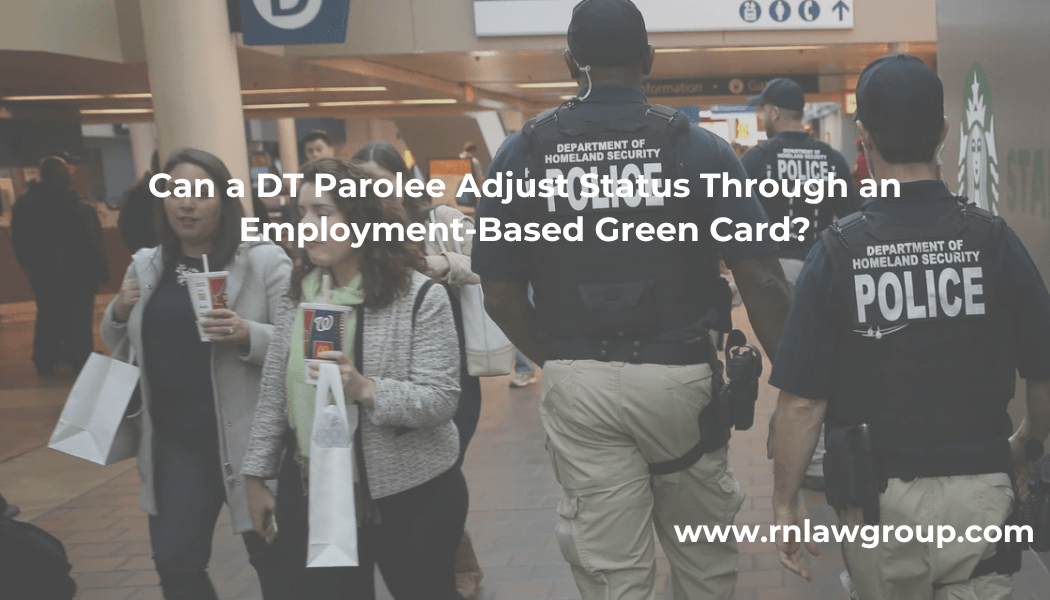
Can a DT Parolee Adjust Status Through an Employment-Based Green Card?
Can someone who was paroled into the United States under DT (Department of Homeland Security – Temporary) I-94 class of entry adjust their status based on an employment-based green card petition? This question has come up frequently in the context of Ukrainians admitted under the “Uniting for Ukraine” (U4U) program and other individuals granted humanitarian parole. The answer, like much in immigration law, is nuanced. While there is no black-and-white regulatory language squarely addressing this for employment-based green cards, recent anecdotal case experience offers some guidance.
This article explores several key issues related to adjustment of status for individuals with DT (Department of Homeland Security – Temporary) status, including what DT status entails and how it arises, the circumstances under which a parolee may adjust status through an employment-based petition, and how the provisions of INA §245(k) apply to those who were admitted under parole. It also identifies common pitfalls in adjustment filings—such as submitting incorrect or incomplete I-94 documentation—and explains why humanitarian parole alone is generally insufficient to meet the legal requirements for a successful employment-based adjustment without a subsequent lawful status like TPS or asylum.
What Is DT and Who Has It?
“DT” is an admission class code used by U.S. Customs and Border Protection (CBP) to designate individuals paroled into the United States for urgent humanitarian reasons. It has become particularly common among those admitted through emergency parole programs, such as Uniting for Ukraine (U4U), and similar initiatives designed to provide temporary refuge for individuals fleeing conflict or crisis.
When a person enters the United States under humanitarian parole, they are not considered formally admitted in either the immigrant or non-immigrant sense. Instead, they are paroled—a critical distinction for immigration analysis. While parole satisfies the first requirement for adjustment of status under an employment-based immigrant visa (e.g., EB-2 or EB-3)—that the applicant was “admitted or paroled”—it does not, on its own, meet the second requirement: maintenance of lawful status.
Adjustment of status via Form I-485 generally involves a two-prong test. The applicant must demonstrate: (1) lawful admission or parole into the United States, and (2) continuous maintenance of lawful non-immigrant status from the time of entry until the adjustment application is filed, unless an exception under INA §245(k) or §245(i) applies. Humanitarian parole, including DT parole, is not considered a lawful status for this second requirement. Therefore, individuals who remain solely in DT parole and do not transition to a recognized lawful status—such as Temporary Protected Status (TPS)—will not be eligible to adjust status through a standard employment-based petition unless they fall within one of the statutory exceptions.
Can DT Parolees Adjust Based on Employment-Based Petitions?
Yes, but only if they obtain a qualifying non-immigrant or protected status before filing their adjustment application.
Real Case Example:
We have successfully represented multiple Ukrainian nationals admitted under the Uniting for Ukraine (U4U) program, all of whom entered the United States with the DT parole designation on their electronic I-94 records, typically for a period of two years. In each case, our strategy involved ensuring a seamless transition from parole to a lawfully recognized status prior to filing for adjustment of status. Specifically, before their initial parole expired, each client applied for and was granted Temporary Protected Status (TPS). Subsequently, before their TPS designation lapsed, we filed the Form I-485 based on an approved I-140 immigrant petition. This approach preserved the clients’ eligibility under INA §245(k), as it maintained a continuous lawful status between their initial entry and the adjustment of status filing.
4o
The Role of INA §245(k)
Section 245(k) offers relief to certain employment-based applicants who failed to maintain status for fewer than 180 days. However, a careful timeline analysis is essential.
Under INA §245(k), the clock begins on the initial date of parole as indicated on the individual’s I-94, and any time spent out of status or merely in parole—not lawful status—counts against the 180-day limit permitted under the provision. However, if the individual transitions to a lawful status such as TPS before accumulating more than 180 days of unlawful presence or status lapse, they may still be eligible to adjust status under §245(k).
Common Mistake: Relying on the Passport Stamp
In one set of filings, we received NOIDs (Notices of Intent to Deny) in four out of five cases because we mistakenly submitted only the passport I-94 stamp, which showed one year of validity. This was inconsistent with the two-year parole period shown on the electronic I-94.
USCIS questioned how our clients maintained lawful presence if the one-year stamp expired before the grant of TPS. Fortunately, upon submitting the electronic I-94s—which accurately reflected the full two-year parole—we received prompt approvals on all cases.
Lesson: Always include the electronic I-94. It carries greater legal weight, especially when the passport entry stamp reflects outdated or shortened information.
Is DT Status Alone Enough?
No. DT “status” by itself does not provide a pathway to employment-based adjustment unless it is followed by a qualifying non-immigrant or humanitarian status. USCIS requires both admission or parole and status maintenance—humanitarian parole satisfies only the first.
Even if someone is “lawfully present” via parole, that is not the same as being in lawful status. Without TPS, asylum, or similar designations, they would be unable to meet the adjustment criteria without running into inadmissibility or ineligibility issues.
The Cuban Act Exception: Not a Model for EB Adjustment
Some practitioners cite the Matter of Olty Cabrera-Fernandez, where the court found conditional parole does not qualify as an “admission” under the Cuban Adjustment Act (CAA). However, this case is not instructive for employment-based filings.
Why? Because the CAA has different standards: the only requirement is that the individual was admitted or paroled—status maintenance is irrelevant. Employment-based I-485s, on the other hand, are governed by INA §245 and require a showing of ongoing lawful status (unless an exception applies).
What If They Never Got TPS?
Without attaining a non-immigrant or protected status like TPS after their DT admission and before filing for adjustment, a person will likely be ineligible for adjustment under an EB petition. USCIS could deny the I-485 for failure to maintain status, even if the applicant was continuously paroled.
In situations where a parolee cannot adjust status based on an employment-based petition due to the absence of a qualifying lawful status, the best course of action may include departing the United States to consular process the immigrant visa—provided there are no inadmissibility issues such as unlawful presence bars. Alternatively, they may seek to re-enter under a different visa category, such as a TN, F-1, or other non-immigrant classification, though it’s important to note that a direct change of status from parole is typically not permitted. Another option, if eligible, is to apply for asylum, although this route falls outside the employment-based immigration framework and involves a separate set of legal requirements and adjudicative standards.
Mexican Nationals and Parole: Unique Challenges
Unlike Ukrainians and many Central Americans who qualify for Temporary Protected Status (TPS), Mexican nationals do not have access to TPS, which significantly complicates their ability to adjust status from DT parole. Because parole does not convert into a non-immigrant status, their options for adjustment are more limited. Practical alternatives may include returning to Mexico to apply for a TN visa—available to professionals with qualifying degrees—consular processing a green card if an I-140 petition is approved, or applying for an F-1 student visa to facilitate lawful reentry and potential future adjustment. However, each of these strategies carries risks, such as triggering a three- or ten-year bar due to unlawful presence, making careful pre-departure legal analysis essential.
Adjustment from DT Parole Is Possible—but Only With Strategic Status Planning
In summary, adjustment of status from DT parole through an employment-based green card is possible, but only under specific and carefully managed conditions. While DT parole constitutes lawful entry, it does not confer lawful status, which is a critical distinction for adjustment eligibility. Individuals must obtain a qualifying lawful status—such as TPS or asylum—after parole and prior to filing the Form I-485. A detailed analysis under INA §245(k) is essential to account for any periods of unlawful presence between entry and filing. It’s also crucial to submit the electronic I-94, rather than relying solely on the passport stamp, to establish accurate parole duration. For individuals without access to TPS, such as Mexican nationals, viable alternatives may include consular processing or returning on a qualifying non-immigrant visa. Attorneys and applicants should recognize that while humanitarian parole opens the door, it does not by itself provide a direct path to adjustment; additional legal steps are required to successfully navigate the process.
For more information, or for a detailed conversation regarding tax filings and potential immigration issues, please schedule a time to speak here.
By: Ryan A. Wilck, Partner and Attorney at Law
Ryan Wilck is a Managing Partner and attorney at Reddy & Neumann, P.C. with over a decade of US immigration law experience, enthusiastic and proactive in his approach assisting clients and their employees through the various phases of the permanent residency a/k/a Green Card process. “Concilio et labore” is not only the motto of Ryan’s favorite sports club but is also his life’s motto; all things come through wisdom and effort. Ryan is passionate about gaining the trust of his clients by utilizing a relentless and detail-oriented approach to understand their specific goals and concerns, hoping to instill a sense of confidence and stability. Whatever your immigration problem or interest, he and his team will find a solution, through wisdom and effort. Reddy & Neumann, P.C. has been serving the business community for over 20 years and is Houston’s largest immigration law firm focused solely on employment-based business immigration. We work with employers and their employees, helping navigate the complex immigration process efficiently and cost-effective.
We are committed to assisting our clients with navigating the complex PERM Labor Certification (ETA 9089 and other challenging immigration matters as an accomplished immigration law firm in Houston, Texas. Our team is here to offer the direction and support you require, whether you’re a company trying to hire top talent or a foreign worker seeking to develop a career in the United States. To find out more about how we can help you with your immigration issues, get in touch with us right away.

